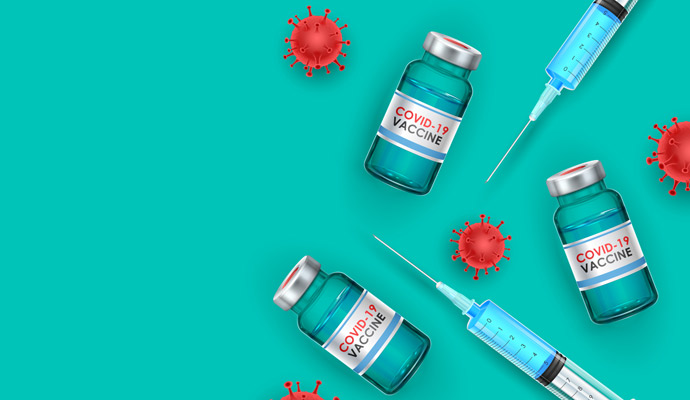Flu Vaccine Patterns Hint To Effective COVID-19 Vaccination Efforts
Flu vaccine strategies give a glimpse into the challenges of COVID-19 vaccination efforts. Effective COVID-19 vaccine rollout can take several pointers from the flu’s failings and successes.

Source: Getty Images
- Promise of the world returning to normal hinges on COVID-19 vaccine rollout. Talk of herd immunity has given people hope that large gatherings, indoor dining, and sporting events will once again become a part of everyday life, or at least an option for daily life.
Herd or population immunity is defined as the protection of an entire group of people from an infectious disease typically achieved through vaccination or previous infection. In other words, if enough people are protected against contracting the disease, the disease stops spreading.
Experts like Anthony Fauci, MD predict between 75 and 85 percent of the United States population will need to be vaccinated in order for the US to achieve herd immunity against the coronavirus.
As vaccination efforts have already shown, this number will not be easy to reach. At the time of this publication, the United States trails behind many other developed countries having vaccinated only 16.7 per 100 people. Over 70 million vaccines have been distributed to states but only 52 million were actually administered to patients.
These statistics point to challenges not only in distribution but in administration. So pharmaceutical companies are increasing their production output and workforces are expanding to allow more people to administer the vaccine.
But will these efforts be enough? President Biden promised in a recent townhall event that all those who want to be vaccinated can be by July 2021. In order to make this a reality, those responsible for vaccine distribution and administration on every level—from government officials to pharmacy technicians—must learn from the successes and grow from the failures of other vaccination efforts.
Flu vaccination efforts happen each year, making it ripe for comparison with COVID-19. To be clear, the flu and the coronavirus are not the same disease. But over the last three years, the flu was responsible for around 117,000 deaths and vaccines have shown to average 69 percent effectiveness.
A novel disease that is more deadly, but also has a vaccine that is more effective, can take some pointers from these yearly inoculation efforts.
Understanding what works for flu vaccine distribution will be critical for patients at high-risk of contracting COVID-19. These individuals have been prioritized by the CDC to receive the vaccine before the general public, as they are at greater risk for severe COVID-19 reactions including intubation, ventilation, and death. Conditions or diseases that put a patient at increased risk of severe COVID-19 include:
- Cancer
- Chronic kidney disease
- Chronic obstructive pulmonary disease (COPD)
- Down Syndrome
- Heart conditions including heart failure and coronary artery disease
- Immunocompromised state from solid organ transplant
- Obesity and sever obesity
- Pregnancy
- Sickle cell disease
- Smoking
- Type 2 diabetes
Xtelligent Healthcare Media examined flu vaccination patterns for patients with these conditions to understand patterns and make suggestions about needed resources for COVID-19 vaccine dissemination.
The Data Insight weighted the 2019 Behavioral Risk Factor Surveillance System (BRFSS) data to make statements about the entire US population. This yearly survey produced by the Centers for Disease Control and Prevention aims to understand health promotion activities from smoking cessation to exercise. Respondents are asked if they have specific chronic conditions and if and where they were vaccinated for the flu, two critical questions used in analysis.
About 60 percent of the population had at least one of the high-risk conditions. The BRFSS does not measure Down Syndrome, organ transplant, or sickle cell disease, so it is likely this number actually larger.
Nearly half (44 percent) of patients at risk of severe COVID-19 received a flu shot in the 2018 flu season compared to 57 percent of the entire US adult population. This is not close to the 75 percent immunized mark needed to achieve herd immunity against the flu.
If efforts for this reoccurring, well-known disease cannot meet the threshold for herd immunity, how can COVID-19 vaccination efforts expect to obtain an even higher rate of vaccination? Lessons learned from flu vaccination efforts can hopefully point government leaders, care providers, and public health officials to the answer.
Proven Efficacy
Patients first want to be assured the vaccine works. Clinical trials have proven the efficacy of the flu vaccine and the Pfizer and Moderna COVID-19 vaccines currently being distributed in the US. Efficacy establishes how well a vaccine or drug works in an ideal setting like a lab or controlled environment.
To understand how a vaccine works in the real world, researchers study effectiveness. Repeated studies have shown the effectiveness of the flu vaccine yet vaccinate rates hover around 50 percent.
The COVID-19 vaccines have not been in market long enough to study effectiveness. This combined with the rise in the anti-vaccine movement and the fast-paced development of the vaccines, has led many to question the validity of the COVID-19 vaccines.
Transparency and education are the keys to reducing vaccine hesitancy. The better an individual understands the vaccine development process, negative side effects, and scientific proof of efficacy, the more confident he can be in the product.

One study found that the greatest predictors of vaccination included the vaccine effectiveness, side effects of the vaccine, and health anxieties. These researchers recommended increasing knowledge to improve vaccination rates.
Promoting trust in the vaccine through increased knowledge can help eliminate vaccine hesitancy. But this begins with educating patients. Is this the responsibility of government officials and local health authorities or healthcare providers and vaccine manufacturers?
Power of Personal Narrative
Personal anecdotes often have more power than scientific evidence. All the facts can point to getting a vaccine but if one patient says he had a negative side effect, it can dissuade hundreds.
This phenomenon is captured in the idea of learning by suffering—those who get the flu are more likely to receive the flu shot the following year, and those who get the flu shot but still contract the flu are less likely to get the flu shot the next year.
Science can point patients in the right direction, but personal anecdotes and experiences redirect patients quickly. To level set, patient-facing providers must be unified in advocating for the scientific evidence of a vaccine’s effectiveness.
Research has shown that a provider recommendation increases the likelihood of a patient being vaccinated. Two-fifths of people who were unwilling to be vaccinated became willing after a doctor’s recommendation.
A doctor telling a patient to get vaccinated is not enough, though. The provider can play a critical role in sharing narratives from her own experiences with the vaccine. Statistics may not be important to a patient. Hearing a provider’s anecdote about the ease of getting the vaccine might carry more weight than listing off statistics.
Local Efforts
Government agencies can coordinate efforts as much as they want but getting a needle in an arm requires infrastructure on the local level.
Previous research has shown that having vaccine access options is effective and actually pushes patients towards being vaccinated earlier. There are multiple locations at which a patient can be vaccinated for the flu, from a provider’s office or the hospital to the workplace and retail stores such as CVS and Walgreens.
Local governments should not take a one-size-fits-all approach. Analysis of the BRFSS data revealed that patients at high-risk of contracting severe COVID-19 were more likely to receive their flu shot at a provider’s office (40 percent compared to 31 percent of the general public). Meanwhile, 17 percent of the general public received a 2018 flu shot from their workplace compared to just nine percent of high-risk individuals.
This discrepancy highlights the need for multiple locations and methods to receive the COVID-19 vaccination. High-risk patients may not be going into work or retail stores to minimize their risk of contracting COVID-19. These potentially risky environments may be avoided by someone trying to stay safe and isolated. But a lower-risk individual might find it convenient to be vaccinated at work or at the store while picking up groceries.
Having the flexibility and infrastructure to vaccinate multiple people across multiple locations will be critical as states begin entering phase 2 and phase 3 of COVID-19 vaccine dissemination. These efforts, though, require coordination from the federal, state, and local levels.
A local municipality with a multi-location inoculation plan cannot put this plan into action without having the doses promised to them by the state. And a federal dissemination plan will be rendered useless if local providers are not trained or equipped to administer the vaccine.
Lessons learned from previous vaccination efforts should guide COVID-19 vaccine distribution measures. It will undoubtedly be a messy process, but some common pitfalls can be avoided if stakeholders learn from past efforts and are focusing on the science, sharing that science, and coordinating efforts across levels of government.
